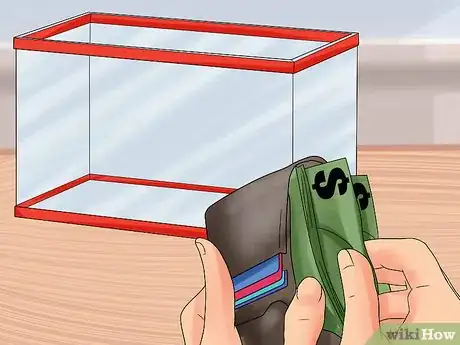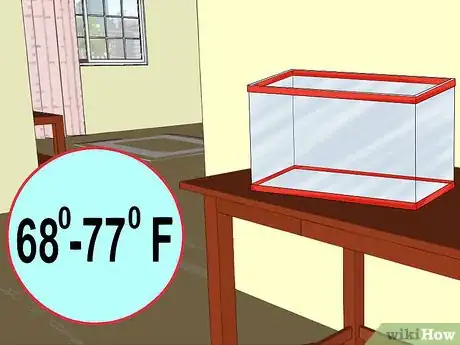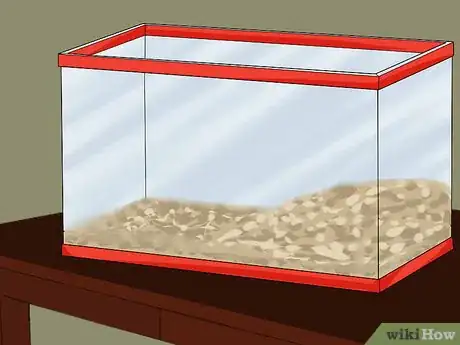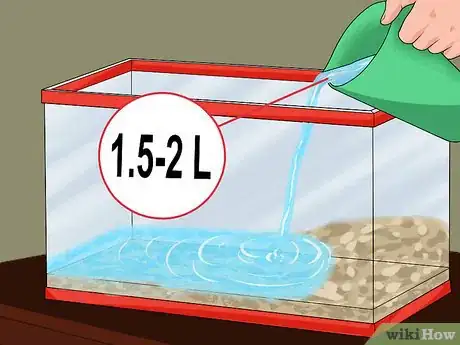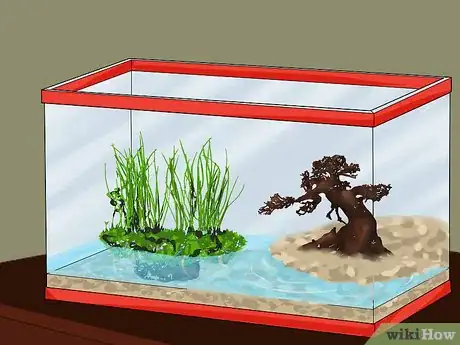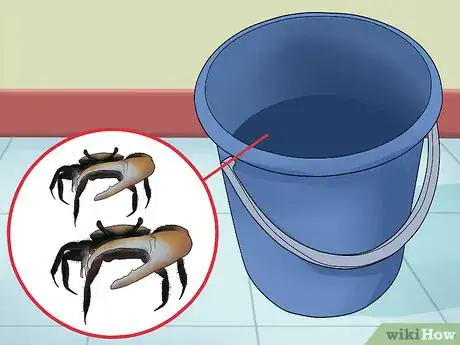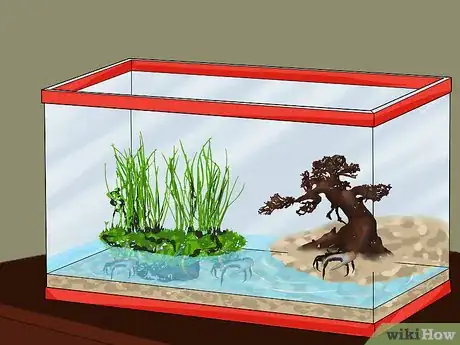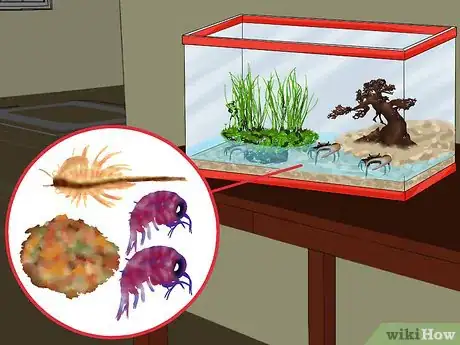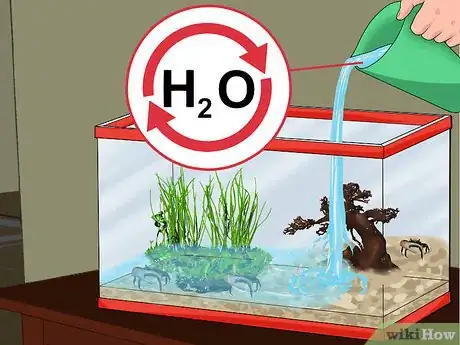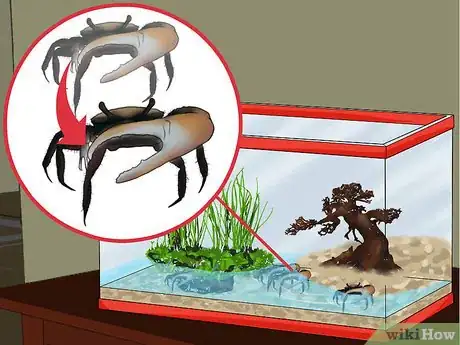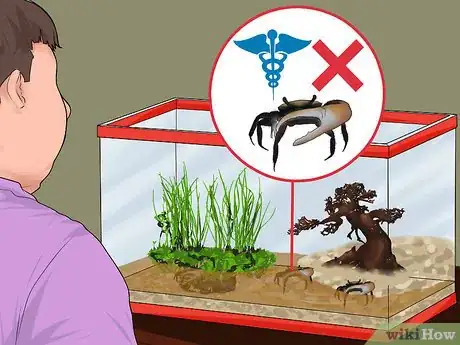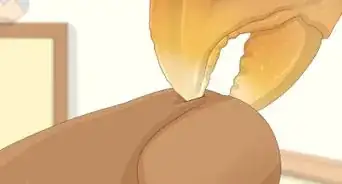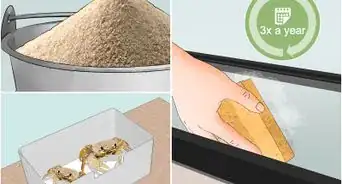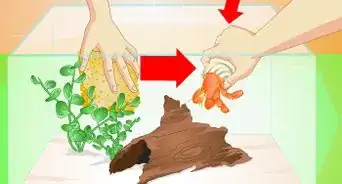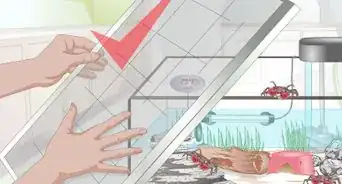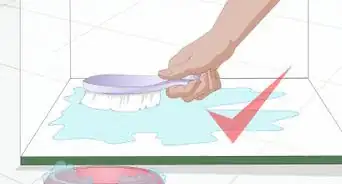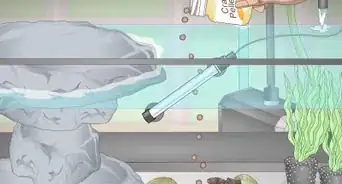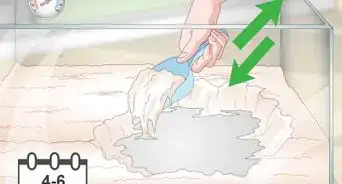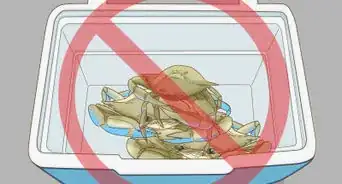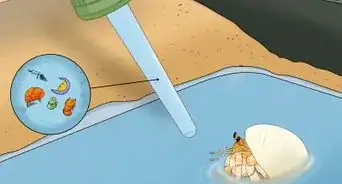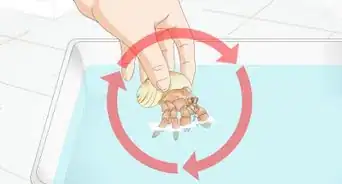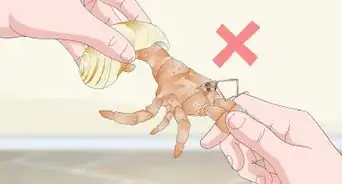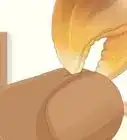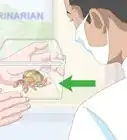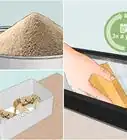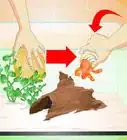This article was co-authored by Pippa Elliott, MRCVS. Dr. Elliott, BVMS, MRCVS is a veterinarian with over 30 years of experience in veterinary surgery and companion animal practice. She graduated from the University of Glasgow in 1987 with a degree in veterinary medicine and surgery. She has worked at the same animal clinic in her hometown for over 20 years.
wikiHow marks an article as reader-approved once it receives enough positive feedback. This article received 13 testimonials and 82% of readers who voted found it helpful, earning it our reader-approved status.
This article has been viewed 210,084 times.
Fiddler crabs are crustaceans common in sandy, marshy, and muddy places of the United States.[1] Fiddler crabs can be colorful and the males have a large claw, which is called a carapace and can resemble a fiddle. Female fiddler crabs have smaller claws.[2] Although fiddler crabs are integral parts of maintaining their ecosystem, they can also be kept in your home as pets.[3] By setting up a proper habitat for your fiddler crabs, you can take care of them.
Steps
Setting Up The Habitat
-
1Purchase an aquarium tank. Fiddler crabs live near bodies of water, so you’ll want to set up something as close tot their natural habitat as possible. Get an aquarium of at least 10 gallons to accommodate your fiddler crabs.
- Buy an aquarium tank commensurate with the number of fiddler crabs you’ll have. For example, if you have four or less animals, a 10 gallon tank will work. However, if the animals are larger or you have more than four, get at least a 20 gallon tank to avoid hostility between the crabs.
- Get the biggest tank you can afford at a pet store or large retailer. You can also often find them second hand, though you should wash these before using them.
- See if the tank has a tank screen for the top because fiddler crabs can climb and escape.
-
2Place the tank in a warm spot. Crabs are more active when their environment is warm.[4] However, direct sunlight can kill fiddler crabs, so you want to put the aquarium in a warm spot out of the direct sun.[5]
- Find a spot that has a relatively consistent temperature of 68 to 77 degrees Fahrenheit (20 to 25 Celsius). Use a thermometer on the aquarium if necessary.[6]
- Make sure the aquarium isn’t exposed to radiators or heating devices or drafty areas of your home.
Advertisement -
3Add sand to the aquarium. Although there is differing consensus on how much sand to add to your aquarium, keep in mind that fiddler crabs are semi-terrestrial and like to burrow.[7] Fill the aquarium with at least a few centimeters of sand so that your crabs feel comfortable.[8]
- Try starting with 4-5 centimeters of sand in the aquarium.[9] Add more if you have multiple crabs or want to give your crabs more space to burrow.
- Use aquarium, play, or bio sand to fill the tank.
- Pile most of the sand on one side of the tank until you get to the level you like.
-
4Fill the tank with water. You’ll need to add a small amount of water to the tank to mimic the fiddler crabs natural brackish-water habitat. Either add a small bowl of water or pour water directly into the tank.[10]
- Fill the tank with 1.5-2 liters of brackish water.[11]
- Make brackish water by mixing 1.5-2 liters of dechlorinated water with 1 gram or ½ teaspoon marine salts.[12] Remember that chlorine can cause stress and kill fiddler crabs.
- Choose whether you want to fill the bottom of the tank with the water or if you prefer to put it in a small glass or plastic bowl that is flush with the surface of the sand.[13]
- Be aware that you want to keep the water as clean as possible because you’ll add your crabs food to the water.[14]
- Recognize that the water and sand mixture may appear brown and cloudy. This is normal and because it will settle throughout the day.
-
5Decorate the tank. You may want to place some decorations or plants in your tank.[15] Fiddler crabs like to hide when they are scared or when they are molting, so placing a few decorations in the tank may make them more comfortable.
- Add plastic plants or sticks because fiddler crabs will often destroy live plants.[16] “Driftwood” types of sticks and rocks are good choices because they let your fiddler leave the water, which is vital to their health.
- Consider adding a piece of PVC piping for them to climb and hide. Make sure to rinse the piping out well before placing it in the tank.
Tending to Your Crabs
-
1Welcome your crabs home. Most people will either order fiddler crabs from a pet supplier or purchase them in a store. Before you set them loose in the aquarium or while you are setting it up, release your crabs into holding containers.[17]
- Use plastic pails or large dishes filled with brackish water as holding containers.[18]
- Avoid leaving your fiddler crabs in any shipping material. Release them into the holding containers and discard any shipping water.[19]
- Keep male and female fiddler crabs in separate holding containers if they arrived separately.[20]
- Cover the containers to keep your fiddlers from escaping.[21]
-
2Release your crabs into the tank. Once you’ve had a chance to remove the crabs from their shipping or arrival containers and set up your tank, it’s time to release them into their new home. Although you can initially release all of your fiddlers into the same tank, watch for aggressive behaviors that may indicate inability to live together.
- Be aware that although fiddler crabs often travel and feed in groups, that they can be aggressive with one another. This rarely results in injury, but you may want to consider separating fiddlers if one doesn’t allow another to move throughout the aquarium.[22]
-
3Feed your fiddlers. Most crabs feed by “grazing” the sand in their habitats throughout the day. Watch for how much your crabs eat and increase food as necessary, though be careful to not overfeed them because this can make the tank smell offensive and like ammonia as well as muddle the water.
- Add the following to your tank every day as food for your fiddlers: one brine shrimp or 2 plankton, a few fish flakes, place these only in the water.
- Change the food up every few days by adding 3 freeze dried blood worms, a few fish flakes, and a couple small pieces of seaweed.
- Be aware that seaweed will promote algae growth in the tank, which your fiddlers will eat.
- Recognize that it is not uncommon for fiddlers to eat rotting food.
-
4Change the water regularly. Fresh dechlorinated brackish water is key to maintaining a fiddler crab’s health.[23] Add new water to the tank as you see it evaporating. If you notice an ammonia smell or murky water, change the water and sand in the aquarium.[24]
- Remember to add water that is dechlorinated and brackish.[25] Never use table salt to make brackish water.
-
5Leave molting crabs alone. Crabs molt their exoskeletons in order to grow. Watch for molting and make sure to leave your fiddler alone during this time because she may be very fragile for several days.[26]
-
6Watch for illness. Disease and illness are rare among fiddler crabs. However, not keeping their water clean or housing them in improper temperatures can lead to illness and death.
- Keep in mind that molting is healthy.
- Be aware that missing claws and legs are normal and will regenerate.
- Checking the water for foul smells can alert you to problems with the water. You may find that simply changing the water makes your crabs more active.
Warnings
- Make sure the fiddler crabs get water because they will die without it.⧼thumbs_response⧽
- Do not put fiddler crabs in a fully submerged tank. They need to come out of the water sometimes, and can die if they can't get onto land. Put some sand in their habitat so they can come out when they need to.⧼thumbs_response⧽
Things You'll Need
- Aquarium
- Freeze-dried plankton, brine shrimp, or blood worms
- Sand
- Water dish (small)
- Tank decorations such as a rock or piece of wood
References
- ↑ http://www.edc.uri.edu/restoration/html/gallery/invert/fiddler.htm
- ↑ http://www.edc.uri.edu/restoration/html/gallery/invert/fiddler.htm
- ↑ http://www.edc.uri.edu/restoration/html/gallery/invert/fiddler.htm
- ↑ http://www.carolina.com/pdf/care-sheets/Fiddler-Crab-CareSheet.pdf
- ↑ http://www.carolina.com/pdf/care-sheets/Fiddler-Crab-CareSheet.pdf
- ↑ http://www.carolina.com/pdf/care-sheets/Fiddler-Crab-CareSheet.pdf
- ↑ http://www.edc.uri.edu/restoration/html/gallery/invert/fiddler.htm
- ↑ http://www.carolina.com/pdf/care-sheets/Fiddler-Crab-CareSheet.pdf
- ↑ http://www.carolina.com/pdf/care-sheets/Fiddler-Crab-CareSheet.pdf
- ↑ http://www.carolina.com/pdf/care-sheets/Fiddler-Crab-CareSheet.pdf
- ↑ http://www.carolina.com/pdf/care-sheets/Fiddler-Crab-CareSheet.pdf
- ↑ http://www.carolina.com/pdf/care-sheets/Fiddler-Crab-CareSheet.pdf
- ↑ http://www.carolina.com/pdf/care-sheets/Fiddler-Crab-CareSheet.pdf
- ↑ http://www.carolina.com/pdf/care-sheets/Fiddler-Crab-CareSheet.pdf
- ↑ http://www.carolina.com/pdf/care-sheets/Fiddler-Crab-CareSheet.pdf
- ↑ http://www.carolina.com/pdf/care-sheets/Fiddler-Crab-CareSheet.pdf
- ↑ http://www.carolina.com/pdf/care-sheets/Fiddler-Crab-CareSheet.pdf
- ↑ http://www.carolina.com/pdf/care-sheets/Fiddler-Crab-CareSheet.pdf
- ↑ http://www.carolina.com/pdf/care-sheets/Fiddler-Crab-CareSheet.pdf
- ↑ http://www.carolina.com/pdf/care-sheets/Fiddler-Crab-CareSheet.pdf
- ↑ http://www.carolina.com/pdf/care-sheets/Fiddler-Crab-CareSheet.pdf
- ↑ http://www.carolina.com/pdf/care-sheets/Fiddler-Crab-CareSheet.pdf
- ↑ http://www.carolina.com/pdf/care-sheets/Fiddler-Crab-CareSheet.pdf
- ↑ http://www.carolina.com/pdf/care-sheets/Fiddler-Crab-CareSheet.pdf
- ↑ http://www.carolina.com/pdf/care-sheets/Fiddler-Crab-CareSheet.pdf
- ↑ http://www.carolina.com/pdf/care-sheets/Fiddler-Crab-CareSheet.pdf
- ↑ http://www.carolina.com/pdf/care-sheets/Fiddler-Crab-CareSheet.pdf
- ↑ http://www.carolina.com/pdf/care-sheets/Fiddler-Crab-CareSheet.pdf
About This Article
To take care of fiddler crabs, start by adding a few centimeters of sand at the bottom of a 10 gallon tank. Next, dissolve ½ tsp of marine salt in 2 liters of water and pour it into the tank. Then, pile additional sand on 1 side of the tank so the crabs have somewhere to rest and burrow. Once your tank is ready, place your crabs inside and feed them every few days with things like fish flakes, brine shrimp, and plankton. Additionally, add more salt water as needed to keep the water level even, and change the water if it looks murky or smells of ammonia. For more advice from our Veterinary co-author, including how to tell when your crabs are sick, keep reading!
